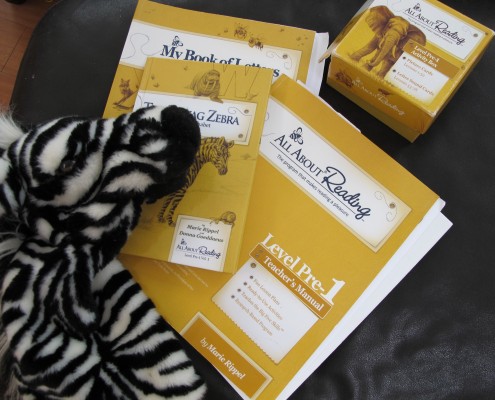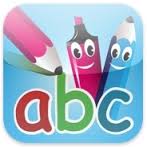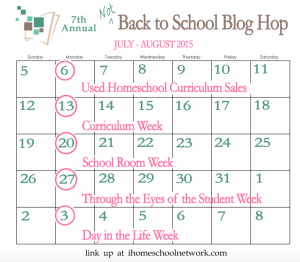Research has shown that the two best predictors of reading success are alphabet recognition and phonemic awareness. These are both things the dyslexic preschooler will probably struggle with. So, homeschool curriculum choices is so important! Here are great curriculum choices for the dyslexic preschooler.

As a relaxed homeschooler, I never was tempted to buy a preschool curriculum for any of our 8 kids – until now. Research has shown that the two best predictors of reading success are alphabet recognition and phonemic awareness. Phonemic awareness is the ability to hear, identify and manipulate individual sounds, called phonemes, in spoken words. Since we can’t rely on the dyslexic to just pick these up by being raised in a reading rich environment like most kids, it makes sense to teach them while they are young.
Our 4-year old has many of the classic early signs of dyslexia and so we plan on being intentional about his preschool this year. Here’s how we’re going to do it:
Teaching Phonemic Awareness
Teaching a young child phonemic awareness and alphabet recognition can be fun!

For an all-in-one, easy-to-use, affordable program for the younger child, I highly recommend the All About Reading Pre-Level 1. This program systematically teaches phonemic awareness and alphabet recognition via multisensory games and that cute, furry zebra puppet – Ziggy.
It is so easy to teach, I’m considering having my 5th or 6th graders teach him. Daily lessons take about 15 minutes to complete.

Another great multisensory tool for teaching the sounds of letters, how to write each letter and early blending skills is the Pocket Phonics App. For more apps for teaching kids with dyslexia, visit our Resources Page.
This one was a surprise for me. A friend told me how her kids ALL learned their letter names and sounds from the catchy tunes on the Leap Frog Letter Factory DVD. My kids loved it and were prone to humming and singing the songs throughout the day. Music is a great way for dyslexic kids to learn. We have collected just about all of their DVDs, including some great Math ones, but if you can only buy one, buy the Letter Factory.
Teaching Preschool Math
Our favorite hands-on, multisensory math program for the younger years is Math U See. Kids can build numbers with base-ten blocks and then practice adding and subtracting. Great for the younger years when abstract concepts are hard to understand.
Building a reading-rich environment in your home
There are some simple and effective ways to prepare your child to learn to read for free, in your own home, without any set curriculum.
Fill your house with books.
Having lots of books in different rooms of the house makes them readily accessible to kids and promotes spontaneous reading either by themselves or with you, the parent. If you’re going to be waiting at a doctor’s office or sports practice have some books in your bag to help pass the time.
Establish good reading habits.
This requires making time for reading in our busy days. Limiting TV and computer time helps drive kids to books for entertainment. Try to find a set time {after lunch, before bed, etc.} everyday that is set aside for reading – either aloud or alone. One of my cues to read to my kids is when they claim that they are bored. If I offer a story, it is almost always received well. As your child grows, this time of reading together will reveal to you if there are any weaknesses in his or her reading ability.
Offer incentives for reading.
If your child is reluctant to read, try some positive incentives to get the reading habit established. Use a simple chart to mark days {we use stickers} when the required reading is done. After a predetermined amount of time, the chosen reward is earned. Choose small things that motivate your child – a trip to a favorite park, a special desert, more computer time.
Set an example with your own reading.
How does the saying go? ‘Attitudes are caught, not taught.’ And ‘the apple doesn’t fall far from the tree’. Be aware of your own attitudes towards reading and make a conscious effort to model enthusiasm for reading in your own life.
Help your child choose books.
Choose books that nurture your child’s current developmental level, such as rhyming books in the early years and graduating to chapter books when the interest level and attention span is there. Also, capitalize on their current interests and choose books and magazines on those subjects to further their love of reading and learning.
The Importance of Reading Aloud
When I was concerned about my young son’s early signs of dyslexia, I spoke to my older kids’ NILD tutor, an expert on teaching reading. He was still too young at 4 years old to start their early intervention program. Her advice was simply, “Read, read, read to him.”
Benefits of reading aloud:
- develops background knowledge about a variety of topics
- builds vocabulary
- builds familiarity with language patterns
- develops familiarity with story structure
- acquires familiarity with the reading process
- identifies reading as a pleasurable activity
Did you ever imagine that by simply reading aloud to your children, you could provide such a rich educational experience?
Linking up today with the ‘Not’ Back-to-School’ Blog Hop:





I completely agree with the Leapfrog Letter Factory! Our boys (8 and 9) started with Leapster Explorers and now have the new LeapPad. I didn’t realize just how much it is sticking until we were doing schoolwork one day and in answer to a question, one of them started to sing that song! Amazing… 🙂